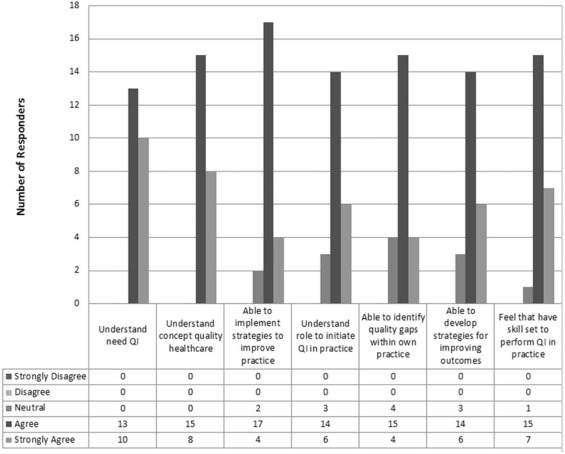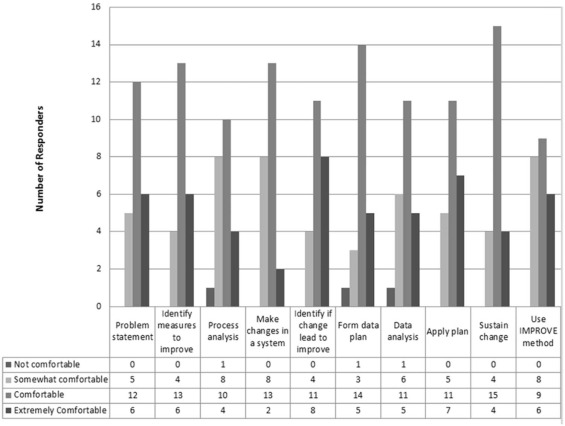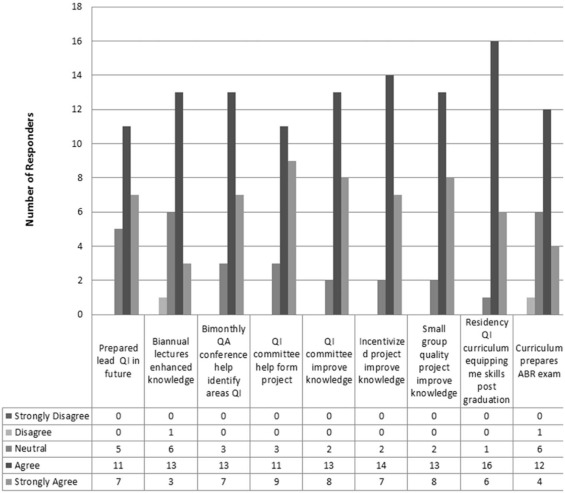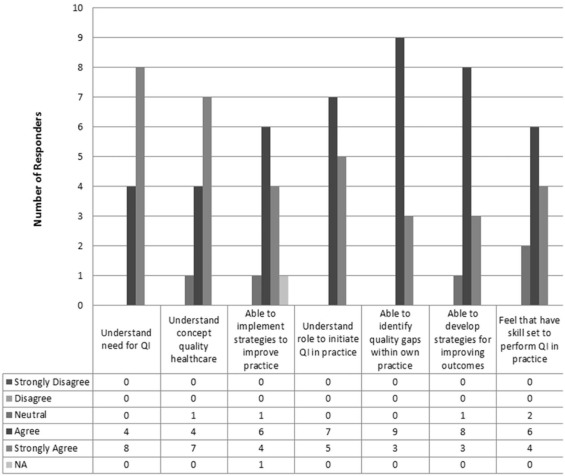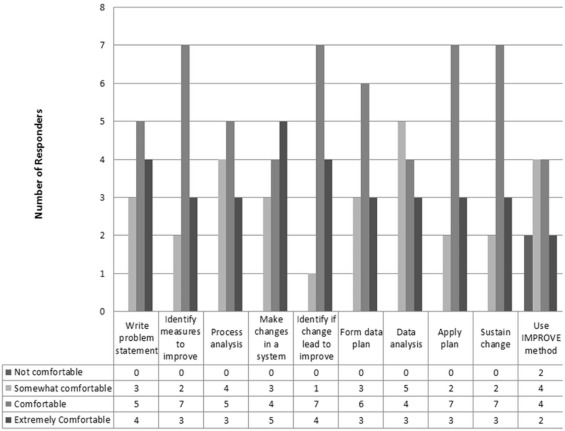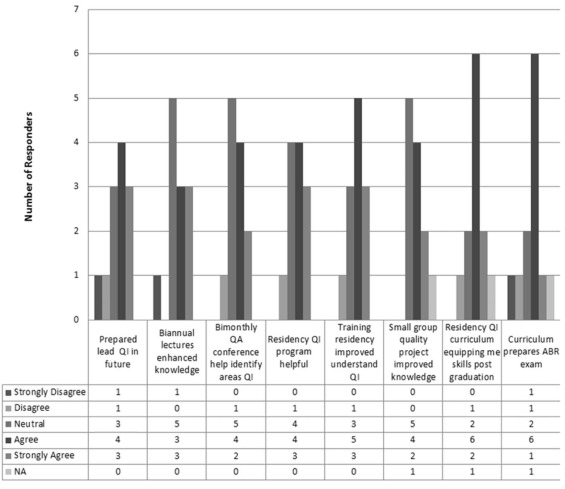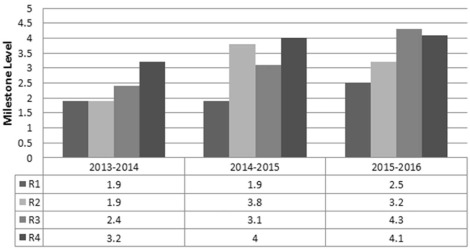Utilization of a radiology resident–specific quality improvement (QI) program and curriculum based on the Accreditation Council for Graduate Medical Education (ACGME) milestones can enable a program’s assessment of the systems-based practice component and prepare residents for QI implementation post graduation. This article outlines the development process, curriculum, QI committee formation, and resident QI project requirements of one institution’s designated radiology resident QI program. A method of mapping the curriculum to the ACGME milestones and assessment of resident competence by postgraduate year level is provided. Sample projects, challenges to success, and lessons learned are also described. Survey data of current trainees and alumni about the program reveal that the majority of residents and alumni responders valued the QI curriculum and felt comfortable with principles and understanding of QI. The most highly valued aspect of the program was the utilization of a resident education committee. The majority of alumni responders felt the residency quality curriculum improved understanding of QI, assisted with preparation for the American Board of Radiology examination, and prepared them for QI in their careers. In addition to the survey results, outcomes of resident project completion and resident scholarly activity in QI are evidence of the success of this program. It is hoped that this description of our experiences with a radiology resident QI program, in accordance with the ACGME milestones, may facilitate the development of successful QI programs in other diagnostic radiology residencies.
Introduction
As the culture of health care shifted to one of value, quality improvement (QI) and system-based improvement initiatives have become increasingly emphasized within the medical community. This affects the specialty of radiology and specifically residency education as programs strive to educate residents and future practicing radiologists on these quality initiatives. Resident education and competence in systems-based practice with assessment by the outcome-based specialty-specific residency milestones is one of the common requirements of the Accreditation Council for Graduate Medical Education (ACGME) . To assess for proficiency in systems-based practice, residents must demonstrate awareness and responsiveness to the healthcare system, demonstrate effective use of resources to provide optimal health care, work effectively and coordinate patient care in various healthcare settings and systems, and advocate for quality patient care and patient care systems . The American Board of Radiology (ABR) also recognizes the importance of QI skills in practice for maintenance of certification .
Residency programs struggle to implement QI into their curriculum. A number of barriers to the success of resident QI initiatives have been identified: lack of education, lack of ideas, limited faculty mentorship, and lack of dedicated time and resources . A few programs have reported diverse approaches including the development of a comprehensive curriculum , a quality assurance elective , a resident QI leadership position , a systems-based practice project requirement , and a dedicated general competency curriculum .
This article provides a practical guide to the creation and successful implementation of a radiology resident QI program comprising a specific QI curriculum and assessment methods in accordance with the ACGME milestones.
Program Development
Our institution is a major academic center with a radiology department of 34 residents (eight to nine per year), 16 fellows, and 41 clinical faculty members. To meet the expectations of the ACGME systems-based QI milestone, a dedicated resident QI program with curriculum was needed to educate residents on QI and to promote resident enthusiasm for improving healthcare quality and patient care. The initial steps in formation of the program included designating a program leader, meeting with the hospital’s department of quality, training of the program leader, formation of the curriculum, and institution of a QI committee related to resident education.
The program leader is a faculty member passionate about QI and education, who is willing to develop and maintain the program, and to be a champion for resident projects. To align the radiology program with the hospital’s quality initiatives and goals, the designated program leader met with the key members of the hospital’s department of quality. After meeting with the Medical Director of Quality, the graduate medical education Director of Quality and Patient Safety, and the manager of the Performance Improvement Department in the medical center’s Office of Quality and Patient Safety, the program leader had a greater understanding of the available hospital resources and their allocation as well as the QI methodology used by the hospital. Furthermore, the leader gained expert mentorship for the radiology residency QI program. Our institution uses a continuous improvement process based on Six Sigma and Lean manufacturing principles called IMPROVE. The acronym stands for I dentify the problem, M easure the impact, P roblem analysis, R emedy the critical issues, O perationalize the solutions, V alidate the improvement, and E valuate over time . Training of the radiology residency QI program leader consisted of a training course on the IMPROVE methodology, attendance of an American College of Radiology annual conference on Quality and Safety , and the online resources Radiological Society of North America Quality Certificate Program and Institute for Healthcare Improvement (IHI) modules .
Resident Education QI Committee
Get Radiology Tree app to read full this article<
Curriculum
Get Radiology Tree app to read full this article<
Project Requirements
Get Radiology Tree app to read full this article<
Time line
Get Radiology Tree app to read full this article<
Get Radiology Tree app to read full this article<
Milestone Assessments
Get Radiology Tree app to read full this article<
Graduate Medical Education Resident Incentivized Plan
Get Radiology Tree app to read full this article<
Resident QI Projects
Get Radiology Tree app to read full this article<
Table 1
List of Projects Completed, Ongoing, and Discontinued by Project Description, Project Duration, and Project Scholarly Outcome
Project Description Project Duration (mo) Project Outcome Patient Care Addressing Bacterial Surface Contamination in Radiology Work Spaces 16
Minimizing the Number of Radiographs in Pediatric PICC Series 16 Oral presentation Annual Quality Congress Improve Critical Results Reporting 10 Oral presentation Feb 2015 ACR annual conference on Quality and Patient Safety Improve Fluoroscopic Dose Reporting 12 Oral presentation internal department QI grand rounds Improve Dose Reporting Pediatric Neuroradiology CT Protocols 10 Oral presentation internal department QI grand rounds Improving Communication Trauma Reporting Criteria 10 Oral presentation internal department QI grand rounds third place Improve CT Shoulder Protocol using 10 point Scoring System 11 Oral presentation internal department conference Improve Pediatric non Neuroradiology CT Dose Reporting 13 Oral presentation internal department conference Interventional Radiology CT Workflow Quality Improvement 12 Oral presentation internal department QI grand rounds second place Reporting Accuracy of Incidental Thyroid Nodules on Neck/Chest CTs 6 Oral presentation internal department conference Improvement of IV Contrast Usage—Decreasing Waste 5 Ongoing Decrease Temporary Status Plain Film x-ray in Pediatric Department with Improved Report Turnaround Times 4 Ongoing Documenting Pacemaker MRI Safety 1 Ongoing Interdepartmental Outside Imaging Upload Protocol Improvement 6 Discontinued
Radiology/ER Ultrasound Reporting Correctness 4 Discontinued
Check-out Procedures for the Residency 6 Discontinued
Improvement in Contrast Extravasation Documentation 6 Discontinued
Decrease Time Involvement in Protocoling for Body or Neuro Studies in Epic 5 Discontinued
Education Improving IR Resident Rotation Experience—VIR Handbook 8 Oral presentation 2015 AUR Annual Meeting Video File for Fluoroscopic Diagnostic Studies 16 Oral presentation internal department conference Moodle Improvement/Resident Communication Improvement 16 Oral presentation internal department QI grand rounds Radiology Study Protocoling Online Resource 8 Oral presentation 2016 AUR Annual Meeting Phone tree—Improving Number Calls Reading Room 12 Oral presentation internal department QI grand rounds Improving Resident Competence and Procedure Numbers of Lumbar Puncture 11 Ongoing
ACR, American College of Radiology; AUR, Association of University Radiologists; CT, computed tomography; ER, emergency room; IR, Interventional Radiology; IT, information technology; IV, intravenous; JACR, Journal of the American College of Radiology ; MRI, magnetic resonance imaging; PICC, Peripherally Inserted Central Catheter; QI, quality improvement; VIR, Vascular Interventional Radiology.
Get Radiology Tree app to read full this article<
Program Feedback
Get Radiology Tree app to read full this article<
Survey Results
Get Radiology Tree app to read full this article<
Get Radiology Tree app to read full this article<
Get Radiology Tree app to read full this article<
Get Radiology Tree app to read full this article<
Get Radiology Tree app to read full this article<
Get Radiology Tree app to read full this article<
Discussion
Get Radiology Tree app to read full this article<
Get Radiology Tree app to read full this article<
Get Radiology Tree app to read full this article<
Table 2
List Resources for QI Education of Residents and Faculty
Agency for Healthcare Research and Quality American College of Medical Quality Institute for Healthcare Improvement: Open School Mayo Clinic Quality Academy Johns Hopkins Medicine Armstrong Institute’s Patient Safety Certificate Program Duke University School of Medicine Online Quality Modules Association of American Medical Colleges (AAMC) Teaching for Quality Program (Te4Q)
QI, quality improvement.
Get Radiology Tree app to read full this article<
Get Radiology Tree app to read full this article<
Get Radiology Tree app to read full this article<
Get Radiology Tree app to read full this article<
Conclusion
Get Radiology Tree app to read full this article<
References
1. Accreditation Council for Graduate Medical Education : Common Program Requirements. Available at http://www.acgme.org/What-We-Do/Accreditation/Common-Program-Requirements/ProgramandInstitutionalAccreditation/CommonProgramRequirements Accessed June 14, 2016
2. Accreditation Council for Graduate Medical Education : Milestones. Available at http://www.acgme.org/What-We-Do/Accreditation/Milestones/Overview Accessed June 14, 2016
3. Accreditation Council for Graduate Medical Education and American Board of Radiology : The Diagnostic Radiology Milestone Project. Available at https://www.acgme.org/Portals/0/PDFs/Milestones/DiagnosticRadiologyMilestones.pdf Accessed June 14, 2016
4. Buchman R.F., Deloney L.A., Donepudi S.K., et. al.: Development and implementation of a systems-based practice project requirement for radiology residents. Acad Radiol 2008; 15: pp. 1040-1045.
5. Otero H.J., Weissman B.N., Rybicki F.J.: System-based practice: proposal for a comprehensive curriculum. Acad Radiol 2008; 15: pp. 119-126.
6. American Board of Radiology : Available at http://www.theabr.org Accessed June 14, 2016
7. Choudhery S., Richter M., Anene A., et. al.: Practice quality improvement during residency: where do we stand and where can we improve?. Acad Radiol 2014; 21: pp. 851-858.
8. Kadom N., Sloan K., Gupte G., et. al.: Radiology residency quality improvement curriculum: lessons learned. Curr Probl Diagn Radiol 2016; 45: pp. 319-323.
9. Hawkins M., Nagy P.: Quality improvement projects for residents. J Am Coll Radiol 2013; 10: pp. 301-302. http://dx.doi.org/10.1016/j.jacr.2012.12.022
10. Krajewski K., Siewert B., Yam S., et. al.: A quality assurance elective for radiology residents. Acad Radiol 2007; 41: pp. 239-245.
11. Sarwar A., Eisenber R.L., Boiselle P.M., et. al.: Improving resident education in quality improvement. Acad Radiol 2013; 20: pp. 500-505.
12. Relyea-Chew A., Talner L.: A dedicated general competencies curriculum for radiology residents: development and implementation. Acad Radiol 2011; 18: pp. 650-654.
13. Medical University of South Carolina : MUSC Quality and Safety. Available at http://www.muschealth.org/quality/index.html Accessed June 14, 2016
14. American College of Radiology : ACR Annual Conference on Quality and Safety. Available at http://www.acr.org/Meetings-Events/Quality-and-Safety Accessed June 14, 2016
15. Radiological Society of North America : Quality Improvement Certificate Program. Available at https://www.rsna.org/Quality_Improvement_Certificate_Program.aspx Accessed June 14, 2016
16. Institute of Healthcare Improvement : Available at http://www.ihi.org/Pages/default.aspx Accessed June 14, 2016
17. Harvin A., VanMiddlesworth K., Botstein J., et. al.: Addressing bacterial surface contamination in radiology work spaces. J Am Coll Radiol 2016; http://dx.doi.org/10.1016/j.jacr.2016.03.022 Epub May 27, 2016
18. Lee C., Wadhwa V., Kruskal J.B., et. al.: Conducting a successful practice quality improvement project for American Board of Radiology certification. Radiographics 2015; 35: pp. 1643-1654.
19. Bucci R.V., Musitano A.: A Lean Six Sigma journey in radiology. Radiol Manage 2011; 33: pp. 27-33. quiz 34–35
20. Lee C.S., Larson D.B.: Beginner’s guide to practice quality improvement using the model for improvement. J Am Coll Radiol 2014; 11: pp. 1131-1136.
21. Institute of Healthcare Improvement : Open School. Available at http://www.ihi.org/education/ihiopenschool/Pages/default.aspx Accessed June 14, 2016
22. Agency for Healthcare Research and Quality : Available at www.ahrq.gov Accessed June 14, 2016
23. American College of Medical Quality : Available at http://www.acmq.org/ Accessed June 14, 2016
24. Mayo Clinic : Mayo Clinic Quality Academy Educational Resources. Available at http://qiresources.mayo.edu/ Accessed June 14, 2016
25. Johns Hopkins Medicine : Armstrong Institute for Patient Safety and Quality Certificate. Available at http://www.hopkinsmedicine.org/armstrong_institute/training_services/workshops/certificate_programs/online/index.html Accessed June 14, 2016
26. Duke University School of Medicine : Quality Modules. Available at http://patientsafetyed.duhs.duke.edu/ Accessed June 14, 2016
27. Association of American Medical Colleges (AAMC) : Teaching for Quality Program (Te4Q). Available at https://www.aamc.org/initiatives/cei/te4q/ Accessed June 14, 2016
